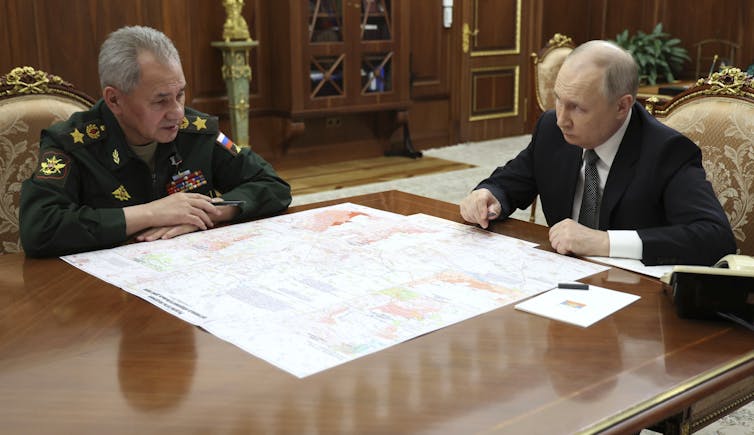May 2024 was a noteworthy month for Russia’s military. Russian President Vladimir Putin replaced Defence Minister Sergei Shoigu with economist Andrey Belousov. Several military leaders were also arrested by the FSB, the Russian successor to the Soviet KGB.

Recent reports suggest these orders came directly from the top levels of the Russian government and have Putin’s blessing. Insiders believe the purges are just beginning, pointing to Putin’s recent replacement of several defence ministry deputies with his cousin’s daughter.
Naturally, Putin’s military purge brings to mind another notable military purge — when Josef Stalin discharged approximately 35,000 army leaders from the ranks and ordered tens of thousands of officers arrested.
Although tempting to make this comparison, there are limits to how much Putin draws from Stalin.
Comparing to the past
Since Russia escalated its war against Ukraine in February 2022, there has been extensive commentary, much of it involving historical comparison. Some have argued Russia’s war in Ukraine is akin to Adolf Hitler’s aggression in the late 1930s. Ukrainians have often drawn parallels between Russia’s weaponization of food and the historical memory of the Holodomor.
Repression in Putin’s Russia since February 2022 has parallels to Stalinist terror. My research, stemming from a 2022 analysis, looks at parallels between Soviet atrocities during the Second World War and Russia’s atrocities in Ukraine today. Some of these parallels are instructive.
For example, a comparison of Red Army sexual violence against civilians during the Second World War to Russian atrocities against Ukrainians today helps us understand the potential long-term consequences. There are other direct inspirations in modern-day Russia from its Soviet past, such as the country’s current use of filtration camps or sending criminals to the front lines to allow them to atone for their crimes “with blood.”
Putin weaponizes history for his own purposes, and the Second World War looms large in Russian national identity. Many Russians view Stalin positively, so it’s tempting to view Putin as emulating Stalin in the decisions he makes. So what about Putin’s recent military purges?

The shocking Soviet military purge
By 1937, Stalin and the Central Committee of the Communist Party of the Soviet Union had embroiled the country in the infamous Great Terror. It targeted those believed to be undermining Soviet goals and led to an extensive purge of the party, affecting citizens across the Soviet Union.
In June of 1937, Stalin agreed to a purge of the Red Army. Eight military leaders, including Mikhail Tukhachevsky, were given a military trial and promptly executed after being accused of forming a “military-fascist plot” inside the Soviet military.

The military purge has often been regarded as the most puzzling of the purges that took place during the Great Terror.
Traditionally, the Great Terror is viewed by many historians as the Soviet leadership rooting out real or imagined spies and anti-Soviet elements. Additionally, Soviet leadership feared an impending world war.
Purging military leadership was therefore a questionable decision. Tens of thousands of Red Army officers were targeted in the Great Terror. Many were discharged and some killed.
Recent research on the 1937 military purges argues that Stalin and Soviet leaders feared spies had infiltrated the Red Army; fearing the impending war, they acted decisively because they believed it was best for Soviet security interests. They acted from a position of weakness. In reality, those targeted were not part of any plot and Stalin’s rule was in no real danger. Yet, Stalin and Soviet leaders feared the worst.
Putin’s purge
Although the rebellion by Yevgeny Prigozhin in the summer of 2023 may have represented a threat to Putin’s rule, the Russian leader has since appeared to strengthen his power and escalated repression. Any speculation that Putin is concerned about security or a military coup therefore seems misplaced.
Many reporters and analysts view Shoigu’s removal in favour of Belousov as Putin signalling he wants to streamline the Russian economy and orient it fully to military production. If so, any comparisons to Stalin’s military purges also seem misguided.
In fact, only one aspect of Stalin’s military purges truly has parallels to Putin’s purge today — the role of the FSB is akin to that of Stalin’s NKVD, the precursor to the KGB, in the current Russian leader’s actions today.

Kremlin spokesman Dmitry Peskov has said the military purges are related to corruption charges. While this could be subterfuge, there is reason to believe his claims are legitimate.
Corruption has long been a major issue for the Russian military. With Russia unable to defeat Ukraine militarily, Putin is using this purge to remove those close to Shoigu and pave the way for a more efficient relationship between the government and military planning for a longer, protracted war. It could also provide a convenient explanation for Russia’s military failures to the Russian public.
Read more: How Vladimir Putin projects his image as a modern-day Peter the Great
In many facets of Russia’s War against Ukraine and in Russian society today, one can find parallels between Putin and Stalin.
Yet not all historical comparisons are helpful. Putin may be influenced by his Soviet upbringing, and future research may find a direct inspiration for this decision from the Stalinist past. But more likely, these military purges are just another example of Putin’s autocratic rule and consolidation of power and not a replay of the past.

